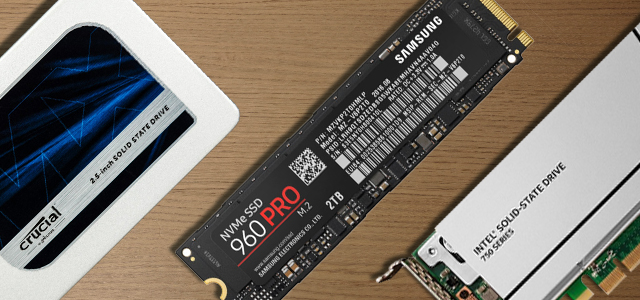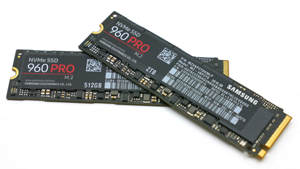
One of the bigger breakthroughs for PC hardware in modern memory has been the solid state drive. And with data transfer speeds many multiples of traditional 7200 RPM and even 10,000 RPM drives, it’s easy to see why. Not only are boot and shut down speeds much faster with SSDs, but all aspects of the system are sped up as well. We highly recommend them. But what about NVMe SSDs, how do they differ from standard SATA drives? And do all M.2 drives classify as NVMe? Read on while we break down the differences between NVMe vs. M.2 vs. SATA.
What is NVMe?

First, a quick note about SSDs – they’re fast. So fast in fact, their limiting factor is not their own hardware, but rather the SATA III connection that hard drives have traditionally used. Enter NVMe. Standing for “Non-Volatile Memory Express,” NVMe is an open standard developed to allow modern SSDs to operate at the read/write speeds their flash memory is capable of. Essentially, it allows flash memory to operate as an SSD directly through the PCIe interface rather than going through SATA and being limited by the slower SATA speeds. Put another way, it’s a description of the bus the component uses to communicate with the PC, not a new type of flash memory. It is also unrelated to the form factor, which is why NVMe drives can come in both M.2 or PCIe card form factors. With both form factors, the component is connecting electrically to the PC via PCIe rather than SATA. Yes, it’s confusing, but stick with us.
Are all M.2 drives NVMe?
No. Remember, M.2 is just the form factor. M.2 drives can come in SATA versions (like the Crucial MX500 M.2 for example) and NVMe versions (like the Samsung 980 Pro), which describes the bus they use to electrically communicate with the other PC components. SATA M.2 SSD drives and 2.5” SATA SSDs actually operate at virtually identical spec. NVMe M.2’s on the other hand, definitely do not, as we’re about to discuss.
NVMe vs. M.2 vs. SATA – Speed
Modern motherboards use SATA III which maxes out at a throughput of 600MB/s (or 300MB/s for SATA II, in which case, it’s time to upgrade). Via that connection, most SSDs will provide Read/Write speeds in the neighborhood of 530/500 MB/s. For comparison, a 7200 RPM SATA drive manages around 100MB/s depending on age, condition, and level of fragmentation. NVMe drives, on the other hand, provide write speeds as high as 3500MB/s for Gen 3 and 7000MB/s for Gen 4. That’s 7x over SATA SSDs and as much as 35x over spinning HDDs!
So which option is best for you? Well, given the speed benefits of the NVMe drives, they’re definitely worth a look, especially if your application is hard drive intensive or requires constant hard drive reads/writes, especially given how much the pricing has come down. For example, the Crucial P3 NVMe we offer is very close in price to the SATA based MX500 – both are M.2 form factor but only the P3 is NVMe. As always, we’re available to assist and point you in the right direction via phone at 804-419-0900 or email at vmsales [at] velocitymicro [dot] com. Check out our selection of Custom PCs here!
Edit: Since this blog was originally posted in 2017, prices on flash memory have continued to drop. SATA SSDs are now only marginally more expensive than HDDs at lower capacities so if you haven’t upgraded yet, the time has never been better!
Josh Covington
Latest posts by Josh Covington (see all)
- RTX 6000 Pro Blackwell - July 1, 2025
- What is CUDIMM? - January 29, 2025
- X870 vs B850: Choosing the Right Motherboard for Your Build - January 17, 2025
So what’s the point of a SATA m.2 drive if still takes up a SATA port? Wouldn’t it be just as good to buy a full size SSD drive?
Quite nice to leave space open inside the case, better airflow etc. SATA M.2s aren’t that expensive either.
Depends on the type of computing, as article describes! However for most people SSD for OS and HDD for mass storage, or external HDD is more then sufficient! This is still far faster compared to Windows Me, slow HHD and Dial Up internet of yore!
I only see the nVME for rapid paced games but more sensibly for multi core advanced processing like the i9, used for engineering design! Or where time sensitive computing is key! It also would be a good idea, to have an affordable lower storage nVME to load OS, several games and basic computing! Especially for iTX builds, where space is a premium!
is pci-e ssd readable by the same port as m-sata?
mSATA was basically the first gen M.2 but the two are not interchangeable. To connect an mSATA in an M.2 connection, you would need an adapter.
Thank you for giving some information about NVMe, M.2, and SATA. This article is very helpful for selecting the best drives.
This was a great article. What it doesn’t cover is if all M.2 slots can take either type of M.2 drive (SATA or NVMe). It is my understanding that they cannot. Is that correct? As a technician, I’m often facing a slot I need to specify a drive for, not deciding on a drive and finding a way to connect it. This appears to say that a M.2 SATA drive can work in an M.2 NVMe slot, but an M.2 NVMe drive won’t work in an M.2 SATA slot. Have I got this right?
“M.2 SATA Ports are not designed to handle NVMe speed: Well, the M.2 SATA Port can only support an M.2 SSD. That is why the speed can never go beyond 600 MB/s. Both physically and electrically, any M.2 PCIe NVMe SSD will not be compatible with your M.2 SATA port. Basically, different protocols and interfaces are used in both these connections.”
“M.2 SATA and M.2 PCIe Ports are different: M.2 is a form factor. It means that certain sizes of SSDs can fit in the M.2 ports. This port is found mostly on the new motherboards. But, they can be of two types. If it is M.2 SATA port, the notch will be placed at the left end. However, if it is made for NVMe SSD, its notch will be placed on the right side and it can work with not only NVMe but with the SATA M.2 devices as well.”
https://ssdsphere.com/can-we-use-m-2-nvme-ssd-on-the-m-2-sata-port/#:~:text=Both%20physically%20and%20electrically%2C%20any,used%20in%20both%20these%20connections.
Hi Cynthia – you are correct, not all M.2 slots are going to be the same. Some are SATA only, some are PCIe/NVMe only, and some are dual use. It really depends on the specific motherboard. You’ll find those exact specifications on the motherboard manufacturer’s site.
Hi, can you help me. I bought MB ASUS Prime Z390-P. And I really dont know if I can use NVMe M.2 drive. what do you mean?
Thanks
Hi Peter. That board should have an NVMe M.2 slot for installing a PCIe Gen 3 drive. You can refer to Asus’s site for more details. https://www.asus.com/us/Motherboards-Components/Motherboards/PRIME/PRIME-Z390-P/
Currently I have a mishmash of drives
3 x 10,000 RPM Velociraptors,
3 NVMe SSDs 1 x 512 and 2x 1TB respectively with one of the NVME SSD being external on a USB3 hub in an external enclosure,
2 x 2.5″ SSD 1 x 512 and 1 x 1TB respectively and
2 x 7200RPM HDD 1 x 2TB and 1 x 1TB
My mother board has room for 2 internal M.2 NVME and Id like to get rid of all the HDD is there a back plane or other device to add MORE NvMe M.2 drives? I bought one pci card that allowed you to add a a M.2 NVMe but UEFI didnt see it so I bought a USB 3 enclosure for my 3rd NVMe Id really like to get this all NVMeM.2 and be all internal in thru the PCI interface I do video editing Visual FX and Unreal Engine Cinematic production
What’s the motherboard?
I’m not sure that is entirely correct. I refurbish desktop & laptop machines for a living – all day, every day. Some m2 drives have a slot on the left, some on the right & some have both(!)
Hopefully your drive will be labelled either NVMe (or PCie) or SATA (or serial) somewhere on it. Other than that, Google the information on the applied label/sticker.
This article helped me decide to go for best SSD drive. Thank you so much for sharing this.
So it means before upgrading the memory have to check the spec of the laptop model which one will support?
Definitely.
This article helped me decide to go for best SSD drive.